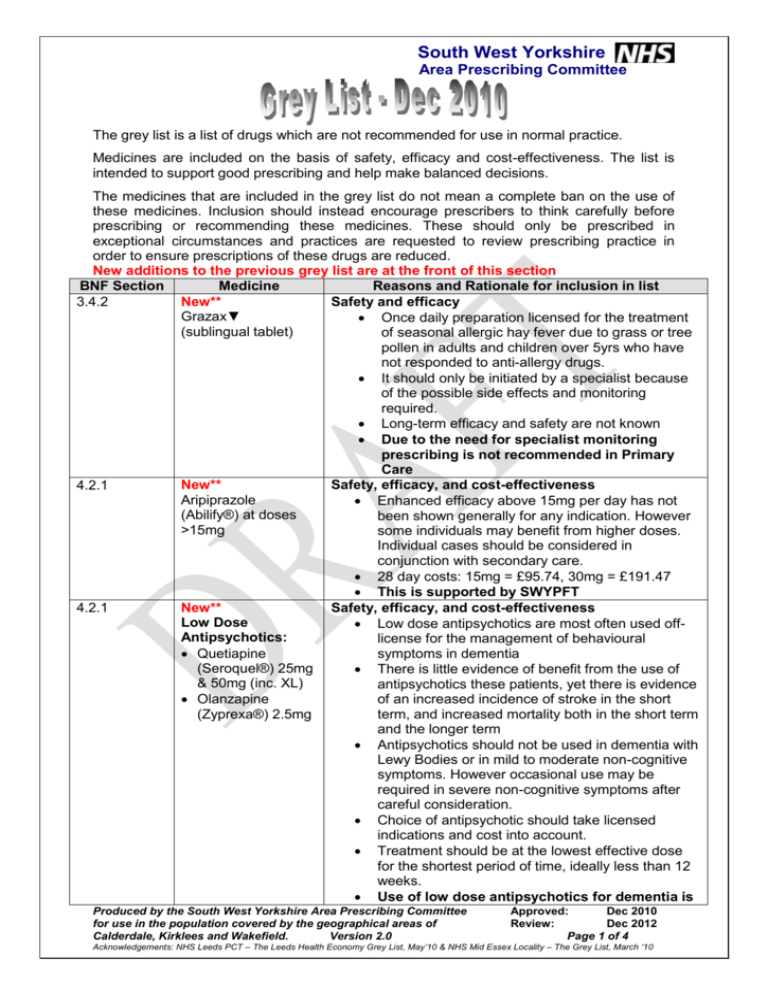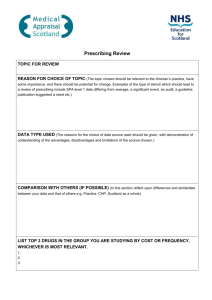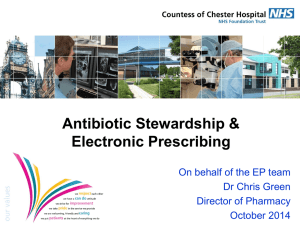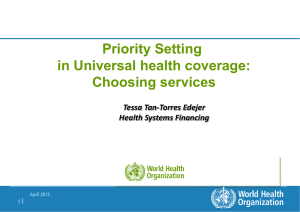What not to prescribe (usually) - South West Yorkshire Partnership
advertisement

South West Yorkshire Area Prescribing Committee The grey list is a list of drugs which are not recommended for use in normal practice. Medicines are included on the basis of safety, efficacy and cost-effectiveness. The list is intended to support good prescribing and help make balanced decisions. The medicines that are included in the grey list do not mean a complete ban on the use of these medicines. Inclusion should instead encourage prescribers to think carefully before prescribing or recommending these medicines. These should only be prescribed in exceptional circumstances and practices are requested to review prescribing practice in order to ensure prescriptions of these drugs are reduced. New additions to the previous grey list are at the front of this section BNF Section Medicine Reasons and Rationale for inclusion in list New** Safety and efficacy 3.4.2 Grazax▼ Once daily preparation licensed for the treatment (sublingual tablet) of seasonal allergic hay fever due to grass or tree pollen in adults and children over 5yrs who have not responded to anti-allergy drugs. It should only be initiated by a specialist because of the possible side effects and monitoring required. Long-term efficacy and safety are not known Due to the need for specialist monitoring prescribing is not recommended in Primary Care New** Safety, efficacy, and cost-effectiveness 4.2.1 Aripiprazole Enhanced efficacy above 15mg per day has not (Abilify®) at doses been shown generally for any indication. However >15mg some individuals may benefit from higher doses. Individual cases should be considered in conjunction with secondary care. 28 day costs: 15mg = £95.74, 30mg = £191.47 This is supported by SWYPFT New** Safety, efficacy, and cost-effectiveness 4.2.1 Low Dose Low dose antipsychotics are most often used offAntipsychotics: license for the management of behavioural Quetiapine symptoms in dementia (Seroquel®) 25mg There is little evidence of benefit from the use of & 50mg (inc. XL) antipsychotics these patients, yet there is evidence Olanzapine of an increased incidence of stroke in the short (Zyprexa®) 2.5mg term, and increased mortality both in the short term and the longer term Antipsychotics should not be used in dementia with Lewy Bodies or in mild to moderate non-cognitive symptoms. However occasional use may be required in severe non-cognitive symptoms after careful consideration. Choice of antipsychotic should take licensed indications and cost into account. Treatment should be at the lowest effective dose for the shortest period of time, ideally less than 12 weeks. Use of low dose antipsychotics for dementia is Produced by the South West Yorkshire Area Prescribing Committee for use in the population covered by the geographical areas of Calderdale, Kirklees and Wakefield. Version 2.0 Approved: Dec 2010 Review: Dec 2012 Page 1 of 4 Acknowledgements: NHS Leeds PCT – The Leeds Health Economy Grey List, May’10 & NHS Mid Essex Locality – The Grey List, March ‘10 South West Yorkshire Area Prescribing Committee 4.2.1 New** Atypical antipsychotic liquids and dispersible tablets 6.3.2 New** Prednisolone entericcoated tablets 10.1.1 New** Diclofenac and misoprostol (Arthrotec®) 10.1.5 New** Glucosamine Hydrochloride/ Sulphate/ Chloride (Alateris)▼ undergoing an urgent review locally and further advice will follow This is supported by SWYPFT Cost-effectiveness There is no need for antipsychotics to be prescribed in liquid or dispersible formulation in primary care unless the patient has swallowing difficulties Liquid and dispersible formulations are more costly than standard formulations. This is supported by SWYPFT Efficacy, cost-effectiveness Large price differential between the enteric-coated and standard prednisolone (current cost for 28 x 5mg tablets is £8.84 for e/c compared to £1.24 for standard) prompted a review of evidence around the perceived gastro-protective benefits of the e/c formulation No evidence that the e/c preparation is less likely to cause peptic ulcers Limited evidence that it is less likely to cause dyspepsia Efficacy, cost-effectiveness • In patients at high risk of NSAID-associated serious upper gastrointestinal (GI) complications, gastroprotection with misoprostol or a proton pump inhibitor should be considered. • Only misoprostol 800 micrograms a day has been shown to reduce serious upper GI complications in a large clinical outcome trial (MUCOSA). • If gastro-protection is required when taking long term NSAID, it is more cost effective to prescribe NSAID and PPI treatment separately rather than combination therapy. Efficacy, cost-effectiveness NICE CG59(osteoarthritis) specifically states that glucosamine +/- chondroitin is not recommended for treatment of osteoarthritis of the knee The latest study reinforces the NICE guidance stating that chondroitin, glucosamine, and their combination do not have a clinically relevant effect on perceived joint pain or on joint space narrowing and recommends that patients should fund treatment themselves should they wish to initiate or continue the treatment. It is available at: http://www.bmj.com/content/341/bmj.c4675.full There is no robust evidence of superiority over paracetamol, at maximum daily doses, for pain relief. Produced by the South West Yorkshire Area Prescribing Committee for use in the population covered by the geographical areas of Calderdale, Kirklees and Wakefield. Version 2.0 Approved: Dec 2010 Review: Dec 2012 Page 2 of 4 Acknowledgements: NHS Leeds PCT – The Leeds Health Economy Grey List, May’10 & NHS Mid Essex Locality – The Grey List, March ‘10 South West Yorkshire Area Prescribing Committee 1.3.5 Esomeprazole (Nexium®) 3.4.1 Desloratadine (Neoclarityn®) 3.4.1 Levocetirizine (Xyzal® ▼) 4.1.1 Melatonin MR 2mg tablets (Circadin®▼) 4.3.1 Dosulepin (Dothiepin) 4.3.3 Escitalopram (Cipralex®▼) 4.3.3 Paroxetine (Seroxat®) 4.7.1 Co-proxamol Cost effectiveness. Isomer of omeprazole N.B. Appropriate option only in patients who have had an endoscopy and scoping specialist has indicated patient has severe GORD or Barrett’s. Cost effectiveness. Isomer of loratadine. No evidence of advantages over loratadine (which is off patent). Circumstances in which use may be appropriate patients who have not tolerated or responded to an adequate trial of other, less costly antihistamines. Cost effectiveness. Isomer of cetirizine. No evidence of advantages over cetirizine (which is off patent). Circumstances in which use may be appropriate patients who have not tolerated or responded to an adequate trial of other, less costly antihistamines. Safety and Cost-effectiveness No comparative trials with existing therapies for insomnia (drugs and/or sleep hygiene) Licensed for over 55s only and max 21 days. More expensive than existing pharmacological therapies if used as 6 x 21 day courses per 12 months No medium/long term safety data N.B. Red for unlicensed indications Relative Safety. Has small margin of safety between maximum therapeutic dose and potentially fatal dose. NICE guidance recommends it should only be routinely initiated by specialist mental health professionals, including GPs with a specialist interest in Mental Health. Similar advice has been issued by the MHRA in December 2007. Cost-effectiveness. Isomer of citalopram – which is off patent. RCT evidence suggests any benefits over other antidepressants are unlikely to be clinically significant. Relative Safety Poor safety profile compared to other available agents. Safety Markedly more toxic in overdose than paracetamol. No robust evidence of superiority over paracetamol alone (acute or chronic use). It is relatively expensive compared to other analgesics- the cost of 100 tablets of co-proxamol is £21.38 For a very small number of patients unlicensed coproxamol can be supplied, on the responsibility of the prescriber. Produced by the South West Yorkshire Area Prescribing Committee for use in the population covered by the geographical areas of Calderdale, Kirklees and Wakefield. Version 2.0 Approved: Dec 2010 Review: Dec 2012 Page 3 of 4 Acknowledgements: NHS Leeds PCT – The Leeds Health Economy Grey List, May’10 & NHS Mid Essex Locality – The Grey List, March ‘10 South West Yorkshire Area Prescribing Committee 4.7.2 6.1.2 Tramadol plus paracetamol (Tramacet®▼) Modified release gliclazide (Diamicron MR®) 6.6.2 7.4.1 7.4.2 9.6.4 Alendronic acid and colecalciferol (Fosavance®▼) Tamsulosin MR Tablets (Flomaxtra XL®) Duloxetine for stress urinary incontinence (Yentreve®▼) Calcium & Vitamin D (calcichew D3®) Calcium 500mg/colecalciferol 200 units per tablet Efficacy, cost-effectiveness Fixed dose combination of 37.5mg tramadol plus 375mg paracetamol per tablet. No more effective than established analgesics in acute or chronic pain. Specialist initiation in exceptional circumstances by pain physicians. Cost-effectiveness Similar effects on blood glucose control as the standard release formulation. Risk of confusion in dose. Cost-effectiveness No convincing randomised controlled trial evidence of benefits over existing bisphosphonate therapy. Cost-effectiveness Generic capsules less expensive than branded tamsulosin tablets. Efficacy, cost Modest effects in women with severe SUI and no benefit in women with mild SUI. NICE advises that it should not be used as a first line treatment for SUI, nor routinely as a second line treatment but only as an alternative to surgery. Efficacy, cost It is thought that a daily dose of 800 units of vitamin D (20microgram colecalciferol) is required to prevent fractures and falls, which this product does not provide. Other calcium and vitamin D products (Adcal D3®, Calcichew D3 Forte® and Calfovit D3®) provide the required daily dose of vitamin D (refer to BNF). Produced by the South West Yorkshire Area Prescribing Committee for use in the population covered by the geographical areas of Calderdale, Kirklees and Wakefield. Version 2.0 Approved: Dec 2010 Review: Dec 2012 Page 4 of 4 Acknowledgements: NHS Leeds PCT – The Leeds Health Economy Grey List, May’10 & NHS Mid Essex Locality – The Grey List, March ‘10







